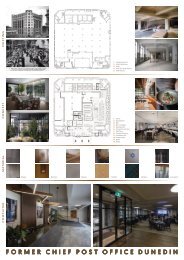You also want an ePaper? Increase the reach of your titles
YUMPU automatically turns print PDFs into web optimized ePapers that Google loves.
European Society of
MusculoSkeletal Radiology
Musculoskeletal Ultrasound
Technical Guidelines
V. Knee
Ian Beggs, UK
Stefano Bianchi, Switzerland
Angel Bueno, Spain
Michel Cohen, France
Michel Court-Payen, Denmark
Andrew Grainger, UK
Franz Kainberger, Austria
Andrea Klauser, Austria
Carlo Martinoli, Italy
Eugene McNally, UK
Philip J. O’Connor, UK
Philippe Peetrons, Belgium
Monique Reijnierse, The Netherlands
Philipp Remplik, Germany
Enzo Silvestri, Italy
Knee
Note
The systematic scanning technique described below is only theoretical, considering the
fact that the examination of the knee is, for the most, focused to one quadrant only of the
joint based on clinical findings.
1
The anterior aspect of the knee is examined with the patient supine. A knee flexion of
approximately 20°-30° obtained by placing a small pillow beneath the popliteal space
stretches the extensor mechanism and avoids possible anisotropy related to the concave
profile that the quadriceps and patellar tendons assume in full extension.
Sagittal US images obtained in the midline while keeping the distal edge
of the probe over the patella display the quadriceps tendon. On long-axis
and short-axis planes, observe the multilayered appearance of this
tendon due to the close apposition and distal union of the three tendon
layers arising from the bellies of the quadriceps femoris muscle. The
ability to discriminate among the individual tendon components has
practical value to allow differentiation between full-thickness (three layers
involved) and partial-thickness (one/two layers involved) tears.
Shifting the transducer cranially
on axial planes, the myotendinous
junctions of the quadriceps
femoris can be appreciated: the
one of the rectus femoris is
located at a more proximal
level compared with those of
the vastus muscles.
Vlat
Vint
Vmed
Legend: arrows, quadriceps tendon; 1,
superficial layer (from rectus femoris); 2,
intermediate layer (from vastus lateralis
and vastus medialis); 3, deep layer (from
vastus intermedius); F, femur; P, patella;
Vlat, vastus lateralis muscle; Vmed, vastus
medialis muscle; Vint, vastus intermedius
muscle
1
Knee
2
Deep to the distal third of the quadriceps tendon, the suprapatellar fat pad is found just
cranially to the patella. Immediately superficial to the femur, the prefemoral fat pad appears
as a large hyperechoic space. The suprapatellar synovial recess lies deep to the
quadriceps tendon and the suprapatellar fat pad and superficial to the prefemoral fat; in
normal states, it appears as a thin hypoechoic S-shaped space. Dynamic scanning during
isometric contraction of the quadriceps
or squeezing the parapatellar recesses
with the non-examining hand may be
helpful to detect small effusions. If needed,
compression with the probe may help to
differentiate effusion and synovial
thickening.
*
*
Legend: arrows, quadriceps tendon; asterisks,
suprapatellar synovial recess; 1, suprapatellar
fat pad; 2, prefemoral fat pad; F, femur; P,
patella
Imaging should be extended over the
lateral and medial sides of the quadriceps
tendon because small synovial fluid tend
to accumulate in the lateral and medial
parts of the suprapatellar recess (which
are dependent with the patient supine)
and within the parapatellar recesses.
Legend: arrowheads, lateral parapatellar recess;
arrows, medial patellar retinaculum; F, femur; P,
patella
3
!"
With full knee flexion, the
femoral V-shaped trochlea
and the overlying articular
cartilage are examined
on axial planes. In
this position, the quadriceps
tendon is pushed
anteriorly by the femoral
trochlea and assumes a
curved course over it.
* *
Legend: arrows, articular cartilage of the trochlea;
qt, quadriceps tendon
2
3
"!
Knee
The medial and lateral retinacula are imaged on each
side of the patella by means of axial planes: they appear
as bilayered structures that cannot be discriminated from
the underlying joint capsule. An attempt to evaluate the
medial articular facet of the patella with US can be made
by tilting and pushing the transducer internally while
keeping the knee extended. The lateral facet is not visible
with US.
Legend: arrowheads, medial
patellar retinaculum; asterisks,
articular cartilage of the medial
facet of the patella; P, patella
*
*
*
#
Check the prepatellar bursa, which is located over the lower pole of the patella and the
proximal patellar tendon: in normal conditions, the bursa is not visible with US. Avoid
excessive pressure with the probe over this bursa not to squeeze the fluid away from the
field-of-view of the US image. Much gel may help to avoid excessive pressure on the
bursa with the probe.
4
With patient’s positioning described at point-1, examine the patellar tendon
from its cranial origin down to its distal insertion using long- and short-axis
planes. Because the lower pole of the patella has a V-shaped appearance,
one should be aware that the tendon inserts not only on the apex but also
along the inferolateral and inferomedial edges of the bone. Short-axis US
images over the proximal patellar tendon should be also performed
because tendinopathy may occur out of the midline.
$!
Legend: arrowheads, patellar tendon; arrow, deep infrapatellar bursa;
Hfp, Hoffa fat pad; P, patella
$!
Deep to the patellar tendon, look at the intracapsular Hoffa fat pad and check the deep
infrapatellar bursa between the distal patellar tendon and the anterior aspect of the tibial
epiphysis. Mild distension of the bursa appears as a small triangular hypoechoic area and
should be regarded as normal. Normally, the superficial infrapatellar bursa is not visible.
3
Knee
5
%&' "("
For examination of the medial knee, the patient is asked to rotate the leg externally while
maintaining 20°-30° of knee flexion. Place the transducer obliquely-oriented over the
long-axis of the medial collateral ligament. Care should be taken to examine the entire
length of this ligament. Dynamic scanning during valgus stress can improve the assessment
of its integrity. Check the soft-tissues immediately superficial to the base of the
medial meniscus.
"
*
Follow the profile of the medial collateral ligament
distally and then rotate the transducer forward to
image the tendons of the pes anserinus complex
(sartorius, gracilis and semitendinosus) in their longaxis.
These tendons are closely apposed and cannot
be separated at the level of the insertion on the tibia
(small convace area).
6
Legend: void arrows, medial collateral ligament; asterisk, medial meniscus; void arrowheads, superficial portion of
medial collateral ligament; white arrowheads, meniscofemoral ligament; white arrows, pes anserinus complex insertion
''
For examination of the lateral knee, rotate the patient’s leg internally while maintaining
20°-30° of knee flexion. Check the iliotibial band on its long-axis down to reach the
Gerdy’s tubercle. If doubts exist on whether the probe is correctly oriented, consider that
the iliotibial band is located between the anterior and middle third of the lateral aspect of
the knee and oriented along the major axis of the thigh. Check the soft-tissues
immediately superficial to the base of the lateral meniscus: when a meniscal cyst is
suspected, examine the knee in forceful flexion to produce bulging of the cyst outside the
joint space thus improving its detection.
!
*
Legend: arrowheads, iliotibial band; asterisk, Gerdy’s tubercle; lfc,
lateral femoral condyle
!
4
Knee
7
("
With extended knee, place the lower edge of the probe on the peroneal head and then
rotate its upper edge anteriorly until the lateral collateral ligament appears as more
elongated as possible in the US image. Just deep to the proximal part of the lateral
collateral ligament, the popliteal tendon can be imaged in its bony groove. Transverse US
planes may help to assess the relationship of the lateral collateral ligament with the more
posterior biceps femoris tendon.
"
*
Legend: arrow, popliteal tendon;
arrowheads, lateral collateral
ligament; asterisk, lateral
meniscus; F, fibular head
8
Check the superior tibiofibular joint for joint effusion and paraarticular ganglia by means of
axial and coronal US images obtained over the anterior aspect of the fibular head.
# "
For examination of the posterior knee,
the patient is asked to lie prone with
the knee extended. Scanning the posteromedial
knee on transverse planes
demonstrates, from medial to lateral,
the sartorius – made, at this level,
of muscle fibers - the gracilis tendon
and the semitendinosus tendon that is
located behind the semimembranosus
tendon.
%$)
*
*
"!
#
Legend: asterisks, articular
cartilage of the medial femoral
condyle; black arrowhead,
semitendinosus tendon;
curved arrow, saphenous
nerve; mfc, medial femoral
condyle; MHG, medial head
of gastrocnemius; Sa, sartorius
muscle; void arrowhead,
gracilis tendon; void arrow,
tendon of the medial head of
gastrocnemius;
5
Knee
9
"""+("
Check the semimembranosus-gastrocnemius bursa between the semimembranosus
tendon medially and the medial head of the gastrocnemius laterally using axial planes
and the cartilage of the posterior aspect of the medial femoral condyle using sagittal
planes.
#
%$)
*
"!
Legend: a, popliteal artery; asterisk, tendon of the medial head of
gastrocnemius; curved arrow, tibial nerve; mfc, medial femoral
condyle; MHG, medial head of gastrocnemius; star, semimembranosus
tendon; Sa, sartorius muscle; ST, semitendinosus tendon;
straight arrows, semimembranosus-gastrocnemius bursa; v,
popliteal vein
10
*,!
In the popliteal fossa, sweep the probe up and down over the popliteal neurovascular
bundle to demonstrate the popliteal artery (deep), the popliteal vein (intermediate) and
the tibial nerve (superficial) which are aligned on an oblique sagittal plane. Because the
patient is prone, the popliteal vein tends to collapse: a small elevation of the leg from the
examination bed, which is obtained while flexing the knee, causes filling of the popliteal
vein and enhances its detection.
'$)
*
%$)
Legend: a, popliteal artery; curved arrow, tibial nerve; F, femur; LHG,
lateral head of gastrocnemius; MHG, medial head of gastrocnemius;
T, tibia; straight arrows, posterior cruciate ligament; v, popliteal vein
More deeply, in the intercondylar fossa, examine the mid-distal portion of the posterior
cruciate ligament in its long-axis using oblique sagittal planes, with the proximal end of the
probe rotated slightly medially in the direction of the medial femoral condyle. If an anterior
cruciate ligament tear is suspected, check the lateral aspect of the intercondylar fossa for
a hematoma (indirect sign).
6
Knee
11
!"
Moving to the posterolateral aspect of the knee, examine the biceps femoris muscle and
tendon by means of long- and short-axis planes. Proximal images must include careful
evaluation of the myotendinous junction of the two heads of the biceps femoris muscle
because this is a common site of sport-related tears. The biceps femoris tendon can be
followed straight downward from its origin to the fibular head. A small sesamoid - the
fabella - can be occasionally seen in the tendon of the lateral head of the gastrocnemius.
Check the cartilage of the posterior aspect of the lateral femoral condyle using sagittal
planes.
!"
!
!
%
!
*
*
12
*
Legend: arrow, fabella; arrowheads, biceps femoris tendon; asterisks, articular cartilage of lateral
femoral condyle; bfm, biceps femoris muscle; M, lateral meniscus; fh, fibular head; lfc, lateral
femoral condyle
From the position described at point-10, shift the probe up over the tibial nerve to find the
origin of the common peroneal nerve from the sciatic nerve. Follow the common peroneal
nerve in its short-axis throughout the lateral region of the popliteal space down to reach
the fibular head and neck. The peroneal nerve is found posteriorly to the biceps femoris.
Note the divisional (superficial and deep) branches of the peroneal nerve that wind the
fibula passing deep to the peroneus longus attachment.
!
!
*
*
(
! (
!
Legend: arrow, peroneal nerve; arrowhead, tibial nerve; asterisks, articular cartilage of
lateral femoral condyle; bf, biceps femoris muscle; fh, fibular head; fn, fibular neck; lhg,
lateral head of gastrocnemius; lfc, lateral femoral condyle; pl, peroneus longus muscle
7
















